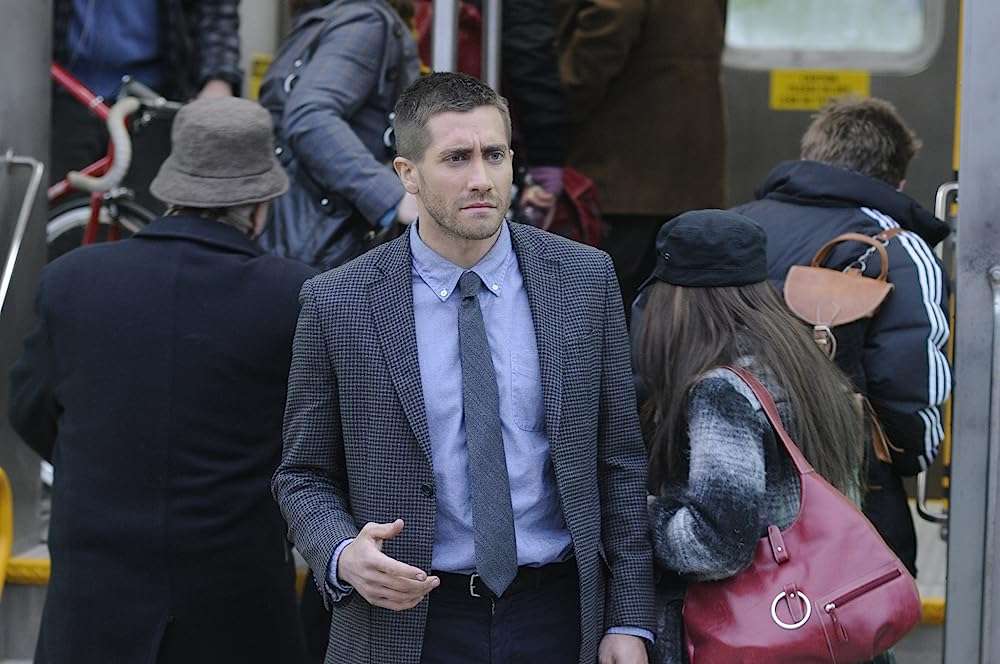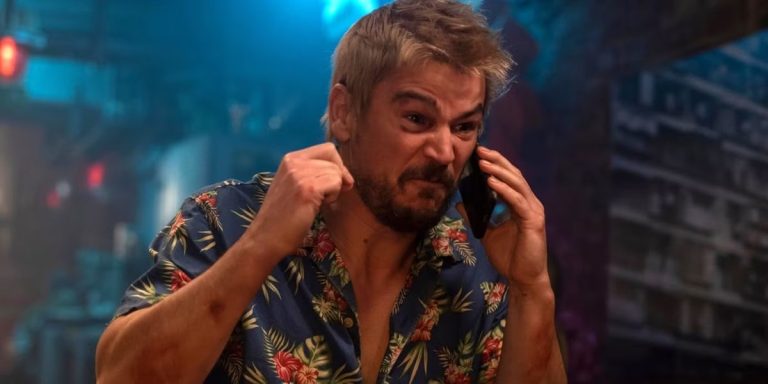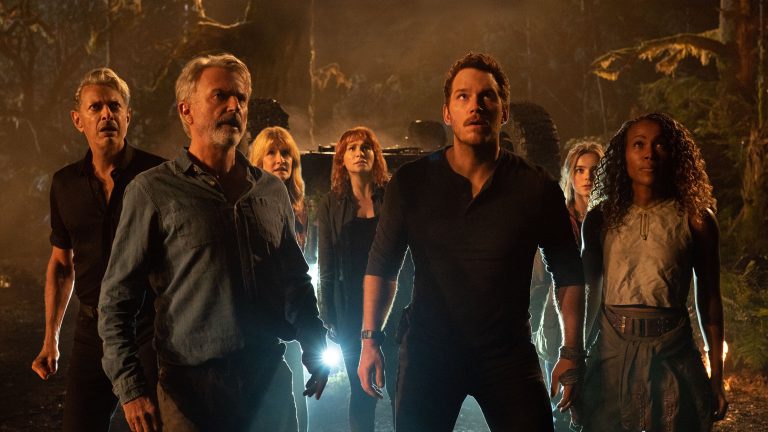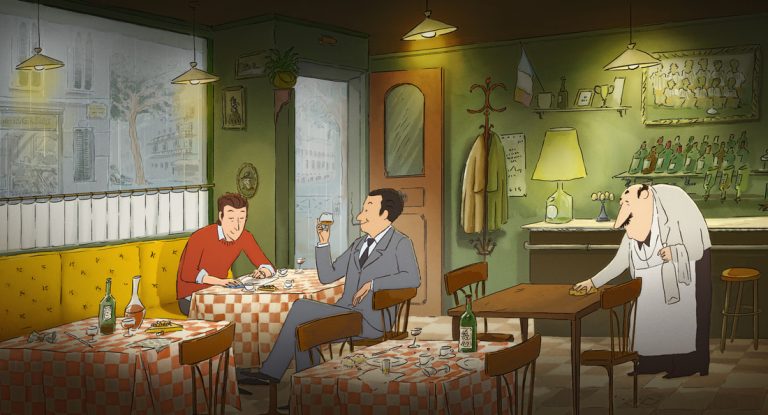Released in 2011, ‘Source Code’ is an enthralling sci-fi thriller directed by Duncan Jones. The film features Jake Gyllenhaal in the role of Captain Colter Stevens, an air force officer who has undergone an amputation. Plunged into the depths of the Source Code machine, his mission is to assist authorities in capturing the culprit behind a train bombing. The narrative unfolds through two distinct timelines or plot universes, skillfully brought to life with meticulous editing and captivating performances by the talented cast. Similar to Jones’s masterly previous film, ‘Moon,’ where Sam Rockwell portrays a miner stationed on the moon, ‘Source Code’ explores the theme of technology’s potential for misuse.
Within the confines of his artistic vision, Jones deftly explores the precarious relationship between technology and human existence, wherein the greater good often overshadows individual lives. Jones navigates the treacherous waters of merging technology and humanity with remarkable finesse, be it the clones of Sam Bell or Captain Stevens’s amputated body.
In cinema, it’s not uncommon for films to draw clear distinctions between reality and fabricated worlds, boldly demarcating the boundaries between the two. However, ‘Source Code’ defies this convention, blurring the lines of this dichotomy throughout its captivating runtime.
The film’s mystical script resonates even in its conclusion, leaving viewers pondering the enigmatic nuances. With the hope of providing clarity and a more comprehensive understanding, this analysis aims to shed light on any lingering doubts and deepen your appreciation of this remarkable cinematic experience.
Source Code (2011) Plot Summary & Movie Synopsis:
The story unfolds as Capt. Colter Stevens (Gyllenhaal) awakens on a commuter train, Next to him is a woman he has never seen before in his life, although she appears familiar. Christina Warren (played by Michelle Monaghan) calls him Sean Fentress, a name that perplexes Stevens. He has no idea about what is going on and abruptly departs from her presence and seeks refuge in the restroom. A startling revelation awaits him as the mirror reflects the image of the person Warren claims he is. However, before he can grapple with this bewildering situation and seek answers, a bomb detonates, tragically claiming the lives of all aboard the train.
Subsequently, Stevens regains consciousness in an enclosed cockpit, securely fastened in a seat while facing a prominent screen. Air Force Captain Colleen Goodwin addresses him as Capt. Colter, providing him with a briefing on his current predicament. As the explanation unfolds, it becomes clear that Colter is embarking on a mission to uncover the identity of the train bomber, who poses a persistent threat of further bombings in Chicago. The source code, an experimental device developed by scientist Dr. Rutledge, becomes Colter’s gateway. Through this machine, he relives the last eight minutes of another compatible individual’s life within an alternate timeline. Driven by his unwavering dedication to serving his country, Colter wholeheartedly embraces his mission. While it takes time for him to grasp the realization that averting the bombing in his own reality hinges on identifying the elusive bomber, he doggedly pursues every lead within the various iterations of those crucial eight minutes.
The narrative takes an unforeseen and truly astonishing twist. Colter discovers the unsettling truth that, in reality, he lies in a comatose state and has been officially declared “killed in action.” Though his consciousness and brain remain intact, a secure facility safeguards his fragmented body. Anger surges through him as he hastily contacts Capt. Goodwin, seeking confirmation of this disheartening revelation. Reluctantly, she corroborates the news. Seizing the opportunity, Colter compels Dr. Rutledge to pledge that he will be allowed to die after fulfilling his mission of identifying the bomber. With this agreement in place, Colter soldiers on, resolute in his purpose.
Finally, he spots the elusive bomber and, after initial failures, successfully obtains the license plate number, which he promptly shares with Capt. Goodwin for verification. The apprehension of the bomber, Derek Frost, within the alternate timeline serves as tangible proof of the source code’s efficacy. Dr. Rutledge, consumed by his exultation over this triumph, commands Capt. Goodwin to wipe Colter’s memories clean, envisioning the repeated utilization of his unique abilities in future scenarios. Goodwin finds herself ensnared in a moral quandary: should she obey Rutledge’s orders, fulfill her duty, and potentially save the lives of countless individuals, or should she allow Stevens to meet the martyrdom he deserves? Yielding to Colter’s impassioned plea for another chance, Goodwin grants him an opportunity to find a resolution.
This time, Colter devises a plan to remain within this timeline indefinitely. He subdues the threat posed by Foster, surrenders him to the authorities, and seizes his phone. With this newfound connection, he reaches out to his father, assuming the identity of a different soldier, thus experiencing a profound and emotionally charged moment that had forever eluded him in real life. As Goodwin prepares to disconnect Colter from the alternate timeline, he shares a heartfelt kiss with Christina. Despite Rutledge’s desperate attempts to intervene, Goodwin successfully carries out her mission. Just before the disconnection, Colter manages to send her an email, which she receives the following day at her workplace in the original timeline, where Colter remains connected to the neural supports. This email serves as both, proof of Colter’s true identity and confirmation of the groundbreaking Source Code project.
Source Code (2011) Themes Analysis:

Advancements in science have propelled us forward, unveiling profound revelations within a remarkably short span of time. Our pursuit of cosmic exploration and the examination of diverse dimensions of our reality have yielded remarkable breakthroughs. Among these groundbreaking discoveries, Professor Hawking’s revelation regarding the expansive nature of the universe and the existence of countless parallel dimensions finds resonance at the heart of ‘Source Code.’ While previous films have tangentially explored the notion of malleable reality, such as ‘Inception’ with its captivating “dream within a dream” premise and ‘Primer’ delving into the complexities of alternate timelines, ‘Source Code’ distinguishes itself by delving into the realm of multi-dimensional reality, unearthing fascinating possibilities hitherto unexplored in cinema.
Pushing the contours of tangible, real-life experiences
‘Source Code’ is remarkably good at undercutting our expectations from reality. Within its cinematic universe, the film webs an intricate and constantly unfolding narrative around a fulcrum-like machine; the beating heart of all conceits. The alteration of the time-space continuum exposes the fallacy of real-world experiences that we have with our surroundings. Challenging such established notions is no easy game. It is the bliss of human ingenuity and curiosity that channels creativity into experimenting with such a bleak story, yet contextualizing it in the heroic sacrificial instinct of a patriot.
It beckons the question: what is real, then? Is Colter’s love for Christina real? Does it have merit for simply how it makes her feel and bypasses the inherent deceit of imposing on someone else? All these questions of great significance about identity and reality lie at the core of ‘Source Code’. The extent to which we can bend God’s will and refashion the world he created remains a challenging question, perhaps one that we do not dread to get an answer for.
Determinism vs. Free Will
Captain Stevens faces the challenge of changing the course of events within the confines of the time loop, leading to a reflection on the limitations and possibilities of free will. ‘Source Code’ jostles with the idea that for even those with a pre-determined fate, there exists the hopeless romanticism of the human spirit. That is the only indomitable, untameable stallion of a force that can move mountains if it wants to. Colter’s belief in changing things is sort of pitted against the conceptual bearings of the experiment. Although the two are not mutually exclusive, as Colter spends more time in the continuum, the line of distinction blurs.
Source Code (2011) Movie Ending, Explained:
The conclusion of ‘Source Code’ sets the stage for an exciting future. The potential sequel can build upon the intriguing open-ended climax of its predecessor. To briefly recap, the Source Code experiment proves to be a resounding success. Dr. Rutledge is ecstatic about the groundbreaking program that holds the promise of saving countless lives. Capt. Stevens returns to the alternate reality and persuades Christina to abandon her work, successfully preventing the explosion and apprehending Frost, whom he hands over to the authorities. As he leans in to kiss Christina, the eight-minute window abruptly closes.
However, their lives are spared since the explosion never occurs, and remarkably, time continues beyond this limited span. Colter lives on, assuming the identity of Sean, within a parallel reality that manifests from the depths of his own mind. Source code effectively grants Colter an opportunity to embrace an entirely new existence. The email is the single most important and complex part of understanding the ending of ‘Source Code’. Below is the what Colter sent to Goodwin, followed by an analysis of what it means:
“At some point today, you’re gonna hear about a failed terrorist attack on a commuter train near Chicago. You and I kept that bomb from going off. An attempted bombing on a CCR train outside Chicago. But it was thwarted, and the suspect was found on board, named Derek Frost. If you’re reading this e-mail, then the source code works even better than you, and Dr. Rutledge imagined. You thought you were creating eight minutes of a past event, but you’re not. You’ve created a whole new world. Goodwin, if I’m right, somewhere at the source code facility, you have a Captain Colter Stevens waiting to send you on a mission. Promise me you’ll help him. And when you do, do me a favor. Tell him everything is gonna be okay”.
Source code’s complex interplay of realities proves to be a blessing for Capt. Colter. It may sound peculiar, yet it holds true. In that final eight-minute iteration, Colter did not die. He was successful in carrying out his mission and also fighting through the obstacles to stay alive for Christina. That fighting spirit bestows upon him a fresh existence within this new reality but also creates an identical world where he exists sans limbs (as Kevin did, as recounted by Michael). The email he sends to Goodwin resides within the source code reality, distinct from the original realm.
Meanwhile, Capt. Stevens remains tethered to life support, and events unfold in accordance with the original reality. In the reflection of Cloud Gate, we witness Christina and Sean, not Stevens, for he remains reliant on life support. The source code reality dominates the entirety of the climactic sequence following Goodwin’s decision to let Colter pass away. It is reminiscent of ‘Inception’, where dreams nest within dreams. This explanation raises a fundamental question: how can an individual possess two consciousnesses? How can divergent thoughts coexist? ‘Source Code’ materializes this phenomenon. This theory alleviates the concerns of Dr. Rutledge and the audience when Goodwin disconnects Colter. Through this ending, Jones ensures that Colter may live his dream of serving the nation while simultaneously experiencing a life imbued with love.








